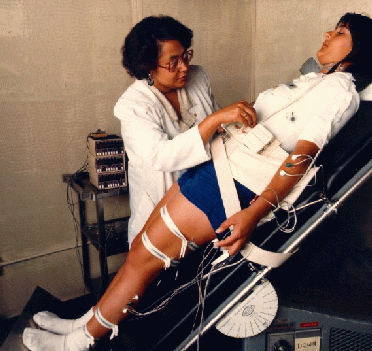In other words, baseline testing. So here I am, set loose in Space City. They rented a car for me on this trip... so either Chad and David are tired of chauffeuring me all around creation, or they figure I can find my own way now [and I sincerely hope it’s the latter]. Johnson Space Center isn’t all that hard to navigate, though the security badge station hands out the most obnoxious map you can imagine. Yeah, with a magnifying glass, a hawk might be able to make out the letters on the guide. But I know enough to find the Cardio-Vascular Laboratories.

The full name of the study, according to the [many fun governmental] pieces of paper I signed, is: “Hypovolemia as a Model of Space Flight: Cardiovascular Effects and Countermeasures.” As usual, everything began with a last-minute pregnancy test, which must always clear the way. Next up was the needle-stick to insert a catheter in my arm, used throughout various procedures for easy blood draws. Then the fun begins!
First up was the Plasma Volume test, which I have done in both the Micro-and Lunar Gravity studies. After a standard quiet period, I breathed through a hose connected to a limestone re-breather. The test determines the amount of blood in the body… nothing invasive and no side effects, just breathing.
Not me.
They shut off the lights to perform a standard Echocardiogram (ECG), which determines heartbeat rhythm – also had many of those during last year’s protocols. And wow, I sure don’t miss someone jamming a cold, goopy transducer into my ribs! But luckily, it’s pretty short… I just have to roll onto my side and they instructed me when to hold my breath as they took 3-D pictures of my heart and blood flow through the valves with ultra-sound (sound waves).
Next up, the dreaded Tilt Test – the only test I did not complete last year due to light-headedness. It tends to make some people nauseous as well, though I’d only ended up with a headache. The test is supposed to be for 30 minutes, but I don’t think I even lasted 15 the first time; my chest grew tight and I told the tech I felt as if I was having trouble breathing, at which point they stopped immediately.
The tilt table itself has a weird effect on the brain. As someone raised on equal parts Spielberg and Roddenberry, plus a healthy dose of “benevolent apocalypse” television (wherein all sci-fi stories use a scary possible future to make a point about the we-can-still-change-it present), the auto-tilting table looks like one of those slabs used for strapping down captured aliens. X-Files, Starman, Close Encounters, pick your poison.

Still not me. NASA Stock photo.
What stops it from feeling like an ET autopsy is that I’m acquainted with everyone here now, and there are fewer unknowns. It’s actually a lot of fun to see all the vascular laboratory personnel in their “native habitat” as opposed to their day trips down to UTMB. They seem more at ease, friendlier and more inclined toward casual SFW humor… plus, I get a better view of their whole reality, their offices, their environment, their daily life and hectic schedules – not just minor episodes where I am helplessly looking up at everyone from a slanted bed.
For a full description of how the tilt works, it’s been added to the list of medical tests, and has its own page with some links to other facilities that use swivel tables.
Later that afternoon was the last test, the Cycle Ergometer. Another test, another blood cath. Another fun pattern of electrodes. This is another test that is also used before and after bedrest, and I did this last summer. Finally created a page and full description, also in the medical tests lists on the sidebar.

So round one is finished! Unfortunately, there won't be a round two. All the tests took place on thursday, and as of friday, results showed that my body wouldn't be a "perfect" candidate for the next segment. No major danger of keeling over or anything; I just didn't fit the initial physiological profile for the protocols.
But stay tuned, and I'll describe what "should" have ideally happened... just in case anyone who's thinking of applying wants to see the details!


































































